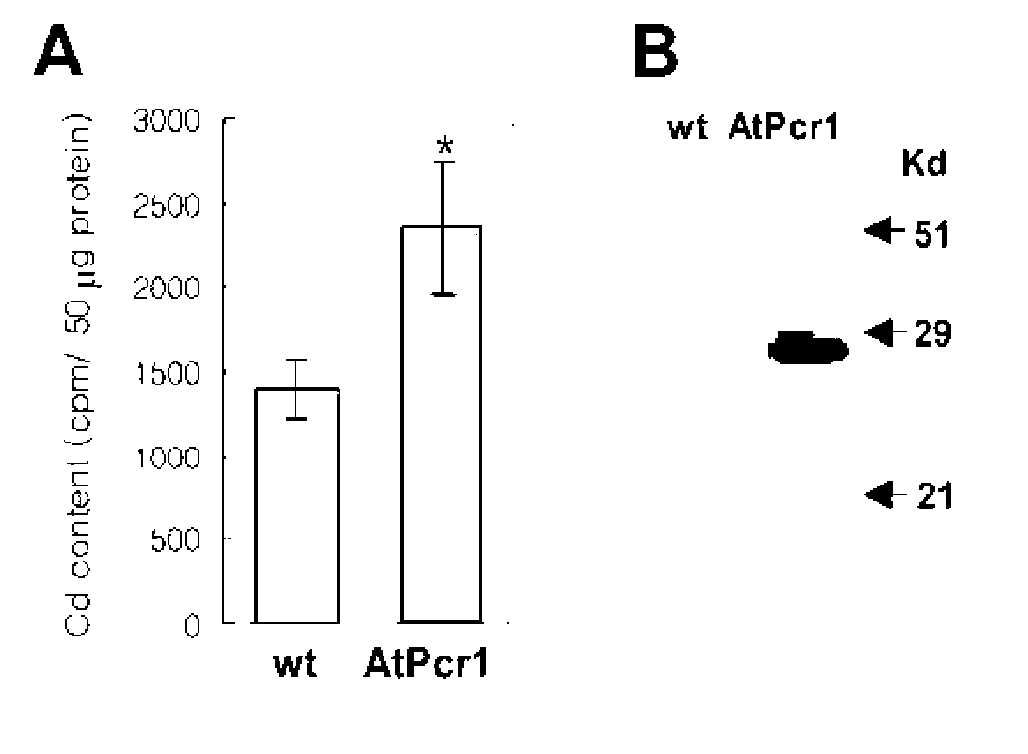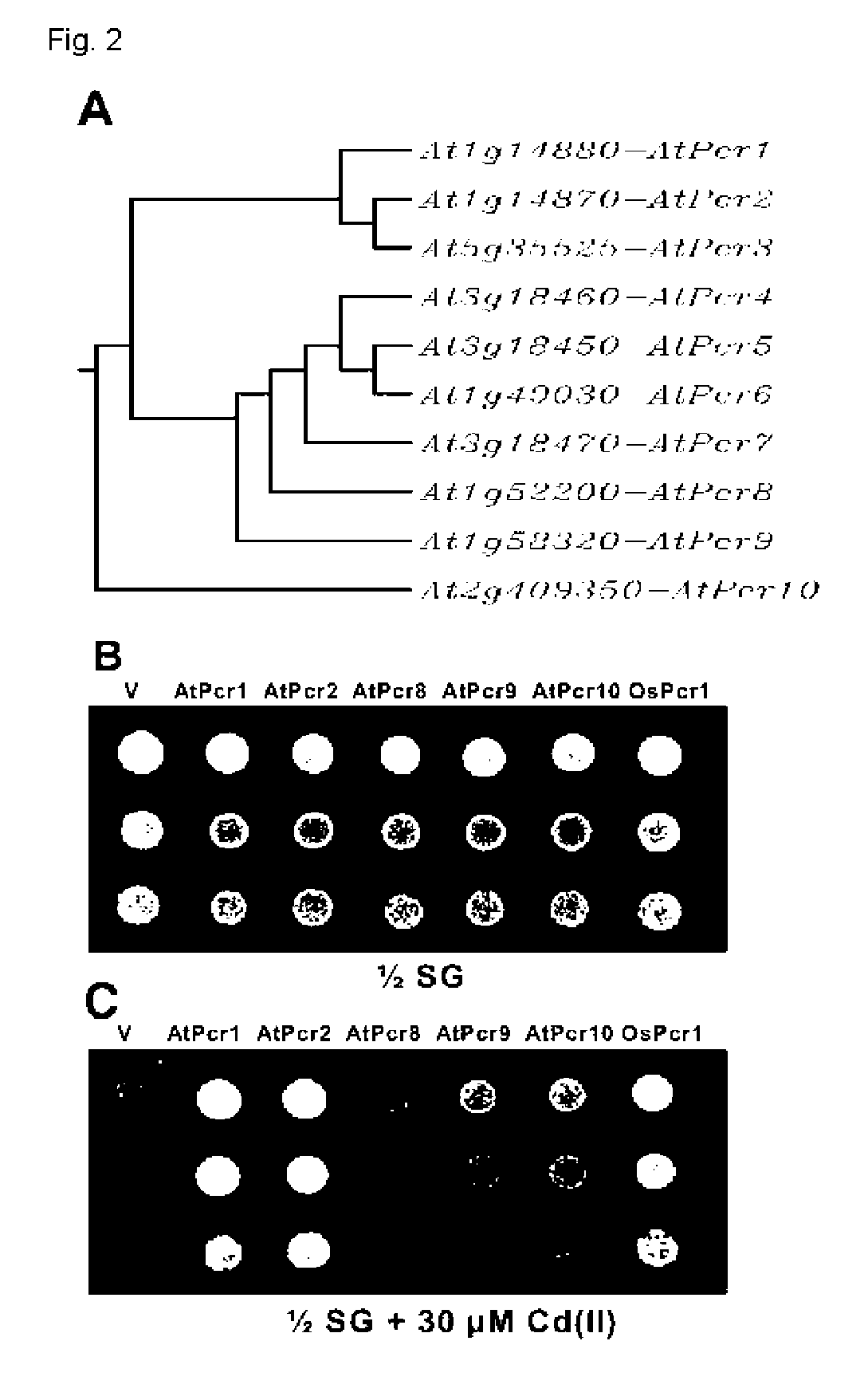Novel Pcr family genes which confer tolerance to heavy metals
a technology of pcr and gene family, applied in the field of pcr gene family, can solve the problems of normal plant growth, dna damage, enzyme inactivation, reactive oxidation species generation, etc., and achieve the effect of improving tolerance to heavy metals and increasing the accumulation of heavy metals
- Summary
- Abstract
- Description
- Claims
- Application Information
AI Technical Summary
Benefits of technology
Problems solved by technology
Method used
Image
Examples
example 1
Cadmium Tolerance of Yeast Transformed with Arabidopsis AtPcr1 Gene
[0032] Wild type yeast, cadmium-sensitive mutant yeast (ycf1), and mutant yeast transformed with Arabidopsis AtPcr1 (P) gene (P-V5 and GFP-P-V5) were cultured in SD-ura solid media. Transformed yeast cells were again cultured in ½ SG-ura solid media including 30-100 uM of cadmium for 5 days. FIG. 1 shows the culture result in ½ SG-ura soild medium and ½ SG-ura solid medium including 50 uM of cadmium. In FIG. 1, Wt is wild type yeast, ycf1 is mutant yeast, P-V5 is transformed yeast where V5 tag gene is attached to Pcr1 gene, GFP-P-V5 is transformed yeast where green fluorescent protein is attached before the Pcr1 gene and V5 tag gene is attached after the Pcr1 gene. As shown in FIG. 1, the ycf1 mutant yeast did not grow in medium including 50 uM of cadmium as good as the wild type yeast, whereas the yeast transformed with the Pcr1 gene of Arabidopsis grew as good as the wild type in medium including cadmium.
example 2
Other Pcr Family Genes Also Confer Cadmium Tolerance
[0033] Genes that have homology to AtPcr1 at the nucleotide base sequences and amino acid sequences were identified from database available. According to similarity of sequences, block diagram of FIG. 2A was prepared. AtPcr1, AtPcr2, AtPcr8, AtPcr9, AtPcr10 and OsPcr1 genes were separated using PCR method and ligated with pYES2 / NTC vector to transform yeast. Using the transformed yeast, cadmium tolerance was experimented. Each primer used in PCR reaction is as follows: AtPcr1 (SEQ ID NO: 7; Pcr1-R1; 5′GMTTCATGGMGCTCAACTTCATGCCAAG3′, SEQ ID NO: 8; Pcr1-X1; 5′CTCGAGGCGGGTCATGCCGCC3′), AtPcr2 (SEQ ID NO: 9; Pcr1-R1; 5′GMTTCATGGMGCTCAACFFCATGCCAAG3′, SEQ ID NO: 10; Pcr2; 5′TFTTMCACTCGTMCMTGTGATCCA3′), AtPcr8 (SEQ ID NO: 11; 5′MCATATGMTTCATGGGTCGTGTCACTACTCCATC3′, SEQ ID NO 12; 5′CTAAAATCAMCTCGAGCFFCGACATATATTGATTT3′), AtPcr9 (SEQ ID NO: 13; 5′ACCAAAAGMTTCATGTCCGMCAAGMGGCAAAAA3′, SEQ ID NO: 14; 5′ATTTFGTGATGTCTCTGAGACGGTCCATGCCTGACGCTA...
example 3
Transmembrane Domain of AtPcr1 Protein Confers Cadmium Tolerance
[0035] Fragments of AtPcr1 protein are shown FIG. 3A. In FIG. 3, S / X is a fragment where C-terminal of AtPcr1 protein was removed and S / K is a fragment which was separated using Sac I and Xho I. Fragment denoted as 5′ is a portion obtained by cutting AtPcr1 with Bam HI and fragment denoted as 3′ is C-terminal portion remained by cutting AtPcr1 with Bam HI.
[0036] After yeasts were transformed with the fragments of AtPcr1 protein, cadmium tolerance was evaluated by culturing them in cadmium-containing medium. The results are shown in FIG. 3B. After yeasts were transformed with the fragments of AtPcr1 protein where CC-CPC of transmembrane domain was substituted by other amino acids, cadmium tolerance was evaluated by culturing them in cadmium-containing medium. The results are shown in FIG. 3C. As shown in FIG. 3B, S / X which corresponds to the transmembrane domain plays an important role in cadmium tolerance. As shown in...
PUM
| Property | Measurement | Unit |
|---|---|---|
| Fraction | aaaaa | aaaaa |
| Fraction | aaaaa | aaaaa |
Abstract
Description
Claims
Application Information
 Login to View More
Login to View More - R&D
- Intellectual Property
- Life Sciences
- Materials
- Tech Scout
- Unparalleled Data Quality
- Higher Quality Content
- 60% Fewer Hallucinations
Browse by: Latest US Patents, China's latest patents, Technical Efficacy Thesaurus, Application Domain, Technology Topic, Popular Technical Reports.
© 2025 PatSnap. All rights reserved.Legal|Privacy policy|Modern Slavery Act Transparency Statement|Sitemap|About US| Contact US: help@patsnap.com



